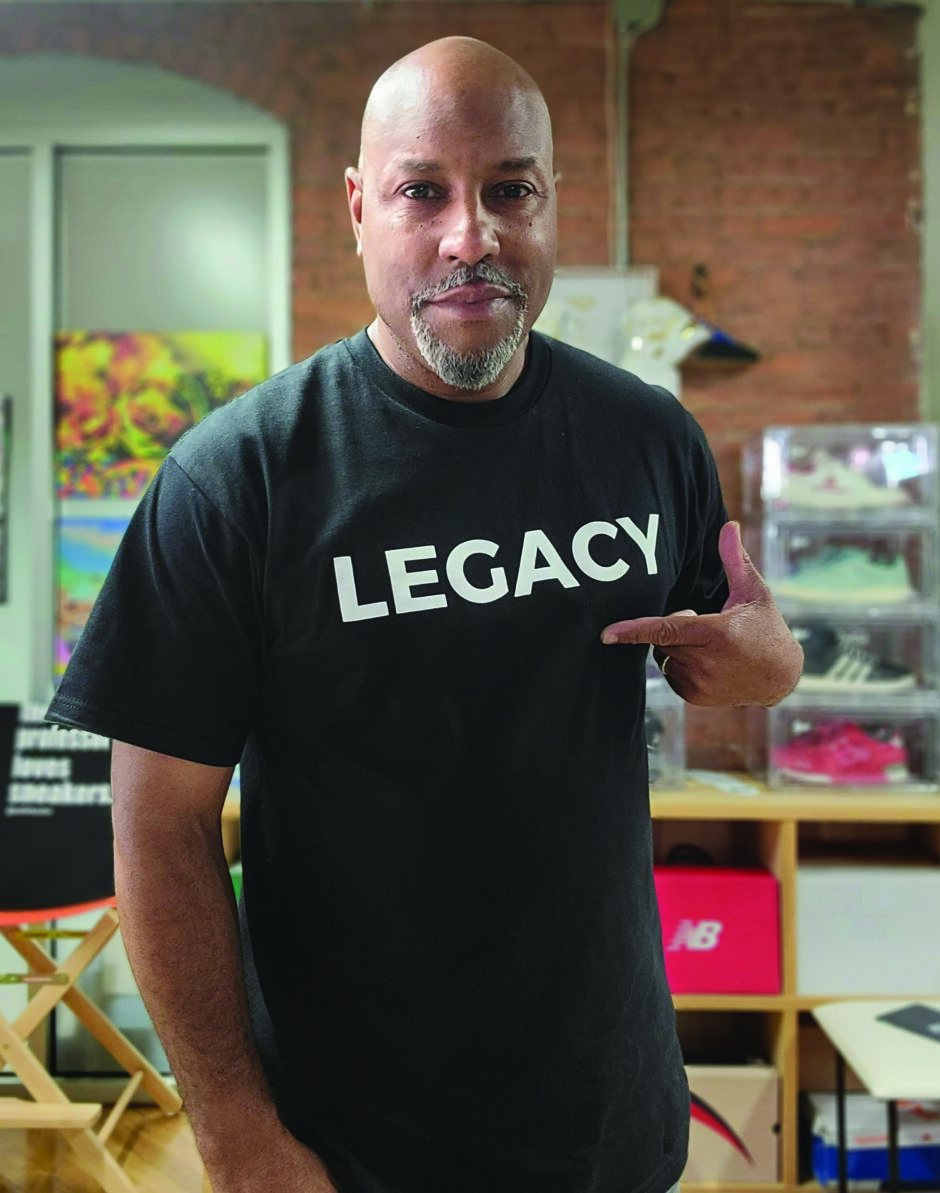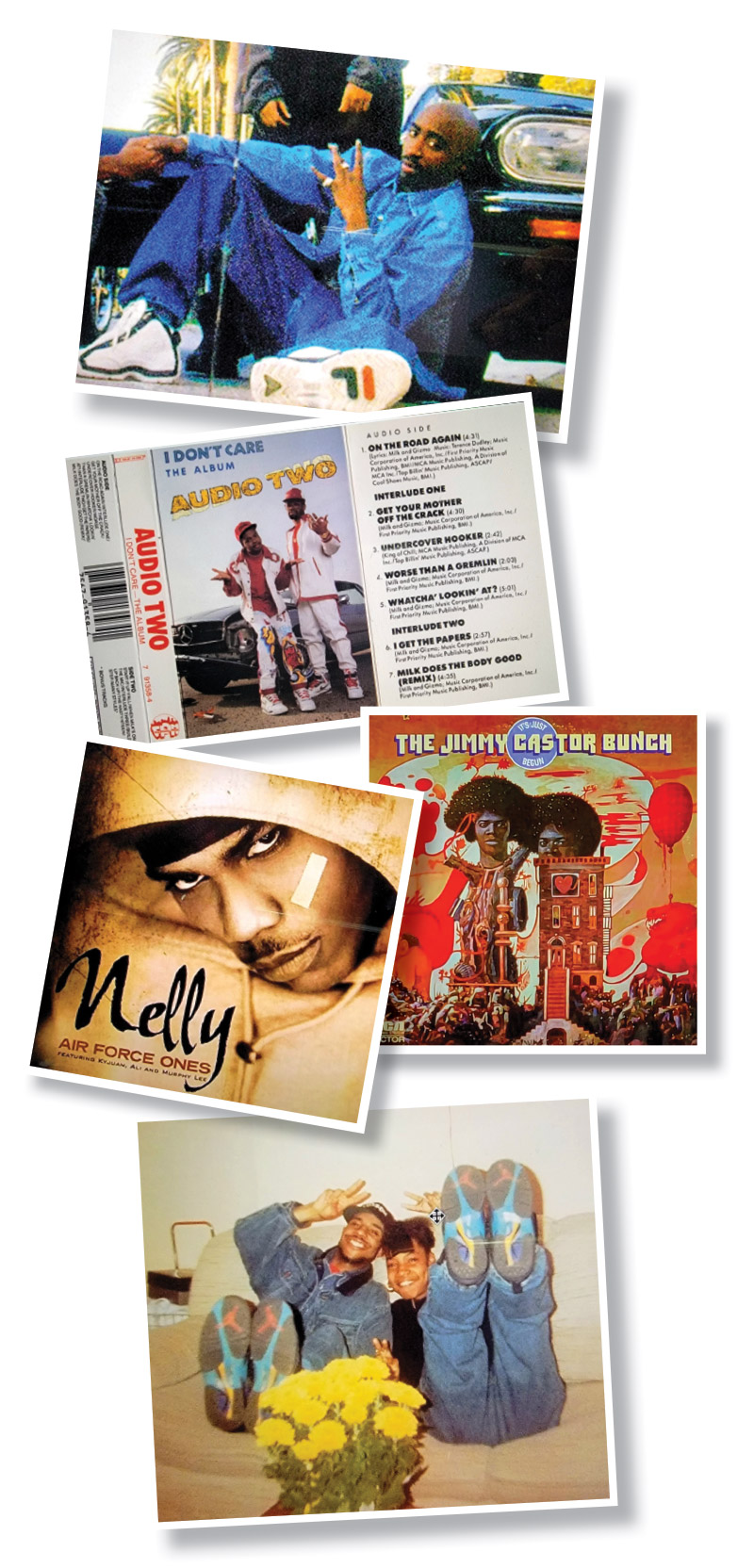
Who can think of Run DMC without thinking of Adidas? The rap supergroup’s 1986 Hip Hop anthem “My Adidas” inspired thousands of fans to hold their Superstars over their heads during concerts. Ditto for the Beastie Boys and Puma Clydes. The cover of the group’s classic 1992 album Check Your Head features band member Ad-Rock sporting the kicks, de rigueur footwear for breakdancers since the early ’80s.
These are just two examples in a long line of iconic pairings of sneakers and Hip Hop, stretching back 50 years to the birth of the genre. Little did fans know then how influential the new sounds exploding from the streets of New York would become—or that the sneakers emerging hitmakers wore would become cultural touchstones, intrinsically linked to every new beat that followed. Sneakers and Hip Hop go together like peanut butter and jelly. And together they’ve conquered the world—two antiestablishment icons, bold, loud, and the epitome of cool.
Sean Williams, a student of both sneakers and Hip Hop since his days growing up in Brooklyn in the ’70s and ’80s, traces the union of the two to the release of “It’s Just Begun” by the Jimmy Castor Bunch in 1972. The soul classic is about optimism, embracing the present, and taking charge of one’s destiny. “It’s a musical metaphor that represents the marriage of sneakers and Hip Hop culture, and what they grew into,” Williams says. “My lifelong involvement personally and professionally in sneakers and Hip Hop dances to that song.”
Williams is a scholar as much as is he is a fan of both genres. After he and business partner Dee Wells created the first sneaker-focused podcast in 2007 (coinciding with the 25th anniversary of Nike’s Air Force 1 release), the duo went on to develop SOLEcial Studies, an educational platform focused on the business of sneakers. Countless people told them no one would want to listen to two guys talk about sneakers. How wrong they were. The naysayers were also mistaken about the pair’s sneaker-based educational platform: They have taught courses in colleges and universities around the world. This fall, Williams and Wells took a leap forward with the opening of the SOLEcial Studies CommUNITY Academy in Brooklyn, America’s first sneaker business and culture school. “In the spirit of Hip Hop culture’s creation and ascendance, we’re doing the same for sneaker culture—one pair and one student at a time,” Williams says. “The aim is to educate and empower more minorities and women to pursue a career in the sneaker industry.”
Williams never envisioned how influential his passion for sneakers and Hip Hop would become. With Hip Hop celebrating its 50th anniversary this year, it’s a time of reflection for him. It’s been a long, strange trip—with killer kicks at every stop. And he wouldn’t trade it for anything. “Here we are at Hip Hop’s golden anniversary, and both genres are as intertwined and influential as ever,” he says.
Below, Williams looks back on loving and living the Hip Hop and sneaker life, starting with his early B-boy dreams and first sneaker crush: Puma Baskets.
The Salad Days

Before I understood how intertwined sneakers and Hip Hop were, I was already living the lifestyle, as Brooklyn’s urban landscape dictated. I had enlisted in the nascent Hip Hop army, even if I didn’t realize it at the time. My mother, Mary Elizabeth Reid (RIP), and I made a deal connecting my academic performance to her buying me my latest must-have sneakers. Good grades equaled fresh kicks. Lesson learned.
One of my first career goals, at age 13, was as an aspiring B-boy. I didn’t perform well in that camp, but at least the Puma Basket kicks I sported held up during all my attempts. I can still see those fat white laces smoothly flowing over each other, thanks to my meticulous lacing technique. I also remember the blue toothbrush I carried—at all times—to make sure the stripe logo stayed super fresh.
Next up: aspiring graffiti artist. Being relatively decent at art, I thought I might have found my calling—along with the right kicks! I was 14 and digging Adidas Superstar and Campus styles. My shoes of choice stood up to the rigors of my new pursuit, which required climbing through the tough terrain of subway stations, train cars, and elevated tracks. My footwear had to perform. The hard rubber shells of my Superstars prevented quite a few mishaps that would’ve likely left me walking differently today or unable to walk at all!
The soundtrack to my graffiti days came courtesy of Kool DJ Red Alert on 98.7 Kiss FM, and Mr. Magic (RIP) and DJ Marly Marl on 107.5 WBLS. Red Alert, now a good friend, rocked a signature military hat paired with whatever were the hottest basketball sneakers of the day. I sported Adidas Rivalry in the tried-and-true New York Knicks colorways. And on the days I ventured into Manhattan after school to work as a messenger, I donned fresh Nike Air Max 1s to make a good impression. I’ve always valued individual expression and my broad range of sneaker styles reflected that. On some occasions, I’d roll up in New Balance 574 joggers or Diadora Borg Elite tennis shoes. Showing up in kicks intended for sports I didn’t play was par for the course. For example, premium leather Bally Triumph tennis sneakers, circa 1986, was another style in my sneaker arsenal. It showed everyone that I rocked to my own beat. Being different was celebrated back then!
The Diddy Days
Around 1990, the sneaker wars were heating up and my role in Hip Hop’s growing army had changed. I jumped feet first into music production, owning my own indie record label. Puma and Adidas moved to the back of my closet, as groups like Audio Two, Eric B & Rakim, and Boogie Down Productions all rocked Nike styles. A new brand king had been coronated.
MC Milk Dee and Giz of Audio Two made a bold statement on the cover of their “I Don’t Care” 12-inch release wearing Nike’s pump-controlled Air Pressure hi-tops. Soon after, Nike’s Air Max collection dominated my sneaker wardrobe, led by my all-time favorite, the Nike Air Max 1. My mid- and hi-top game also featured styles by Reebok, Air Jordan, Avia, Spot-Bilt, Adidas, and Converse, among others. I even got my younger sister, Sheree, in on the act with Aqua Air Jordan 8s, which we purchased together on the release date in 1993.
The Hip Hop scene in New York was the epicenter of all things independent in the ’90s. That’s when artists like Eminem, Jay-Z, Snoop Dogg, Biggie Smalls, Nas, and others found fame. Sneaker-wise, we continued to embrace individuality. There was none of today’s lockstep “released on Saturday, everyone wears them on Monday” behavior. Fila took a turn in the spotlight, led by its iconic Grant Hill 2 basketball shoe. Tupac Shakur wore it on the All Eyez on Me album insert released in 1996. Hip Hop was edgy, and the shoes we sported were tough. Who cared if a sneaker weighed as much as a boot? Those days are long gone!
It’s a Wonderful (Sneaker) Life
The new millennium marked the dawn of a new age for sneakers and Hip Hop. And1 crashed the party in 2000 as a brash new brand ushered in by Vince Carter’s NBA All-Star weekend dunk contest win for the ages. I’ll never forget that 360-degree, windmill monster jam with Carter sporting And1 Tai Chis. It put the brand on the map.
Adding another pin to the map for Hip Hop was GhostFace Killah’s album Supreme Clientele. Even though Ghost was known as “Wally Champ” for his love of Clarks Wallabees, he wove sneaker and apparel references into his rhymes often. Sometimes I felt like we were shopping in the same places at the same time! His Wu-Tang Clan bandmate, Raekwon the Chef, also sparked a ton of footwear nostalgia in his 1999 song “Sneakers,” which name-dropped an array of classic styles. Other noteworthy Hip Hop albums released that year included
Eminem’s The Marshall Mathers LP, The Dynasty: Roc La Familia by Jay-Z, and the incomparable Busta Rhymes’ Anarchy. Eminem has since partnered with Nike on 30 amazing collabs!
As the aughts wore on, there was a shift from overbuilt shoes to retro styles led by Nike Dunk and Jordan Brand. This trend is strong to this day. Hit styles included Vans Authentics, Adidas Stan Smiths, Converse All Stars (they never go out of style), and Fila Disruptors, to name but a few. Songs like Nelly’s “Air Force 1s” became a soundtrack to a lot of ’hoods across the country. As much as I disliked that song, it’s an undeniable ode to that 20-year-old sneaker’s legacy. Still, I’ve never owned white-on-whites in any brand. I just can’t go there, stylistically.
Hip Hop’s influence on sneakers and vice-versa is stronger than ever today. And while these days sneaker drops come at us faster than Buster Rhymes raps, I can never get enough. Every new sneaker is a story—just like every new Hip Hop track. And after 50 years of marriage, the bonds between sneakers and Hip Hop are tight. I expect they will stick together for decades to come. Thank you for the memories. Happy golden anniversary, Hip Hop, and long live sneaker culture! •



